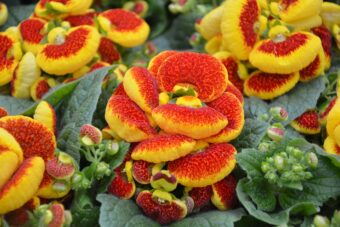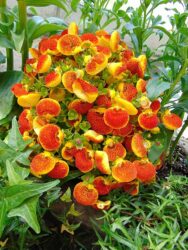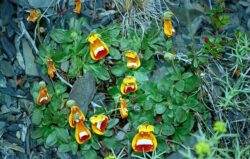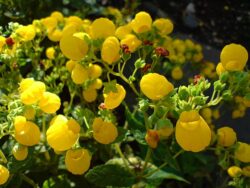In this article, we will discuss how to grow Calceolaria in containers. If you are looking for a plant that is showy, unique and brightly coloured then the slipper flower is for you. It gets its common name because the flowers have pouches at the bottom, giving a look of a purse or slipper.

To the inexperienced eye, it looks like a type of orchid but it is not. There are more than 300 different species in the genus, but all of them have been cultivated and hybridised from Calceolaria integrifolia. This has given rise to several compact varieties that are often used and treated as annuals, where they can be seen as part of containers and hanging basket displays. In warm areas of the world, it is a perennial, but in the UK they are treated as annual bedding plants to be throughout at the end of the growing season.
The colours you tend to find the plants come in are often vibrant yellows and oranges that sometimes have distinct red markings. There is no point in trying to bring the plants indoors for winter, as they only flower once in their whole lifetime.
They are short plants, generally only growing 30cm in height. This is the reason why they should be planted in front of the container, where they will not be swamped by other taller flowers.
HOW TO GROW CALCEOLARIA IN CONTAINERS
You have two choices for these plants, either growing from store-bought plants available in spring or from seeds. I will be honest with you, they are not easy to look after. Get the growing conditions wrong and the plant will not like it. If you do this, they will be in bloom for several weeks. You can grow them as a houseplant but they make a better impact if it is grown as part of a summer bedding container display.
GROWING FROM SEED

Buying plants is far easier than growing from seed. It will be best to buy them as garden-ready plants as they only last one growing season.
You can try if you want to do this but you will need to buy some viable seeds.
From June to October, fill a seed tray with a good quality seed compost and water it well, ensuring the compost is moist. Sprinkle the seeds on top thinly and do not cover with any more compost or vermiculite.
Place a propagation lid over the tray and place it on a propagator or heat mat on a sunny windowsill. Once they have germinated and are large enough to handle, you can prick them out and transplant them to individual 7.5cm pots full of multipurpose compost. Make sure the compost is evenly watered and not over wet, which can lead to fungal diseases and the death of the plant. Conversely, do not allow the compost to get too dry.
PLANTING OUT CALCEOLARIA
At this stage, the garden-ready, shop-bought plants and home-reared plants can be treated the same way. In May, the following year, you can harden them off for planting them in their final location.
Find a container that is suitable for the plants in question. You can plant a group in containers or better mix it with other oranges, reds or yellows to give an instant impact. Make sure it has plenty of drainage holes at the bottom and fill it with gravel to a depth of 1cm. On top of this add a mix of 80% by volume multipurpose compost with 20% by volume of horticultural grit.

Dig a hole in the compost that is slightly bigger than the root ball of the plant in the original container. Drop a plant in at the same level, so that the top of the root ball is level with the top surface of the compost. Backfill with the growing media, ensuring that any gaps that remain are filled with more compost. Firm the plant in and water well.
Place the container in a slight shade, where it will not receive too much direct sunlight. Too much shade will cause the plant to lose its flowers and petals.
WATERING IS VERY IMPORTANT
Watering is very important for Calceolaria as overwatering will lead to root rot and the death of the plant. On the other hand, if the soil gets too dry all the petals will drop off and the plant will wilt. When it feels dry at a depth of 2.5cm below the compost, it is time to water. Make sure you avoid the crown as this can lead to crown rot.
This is one plant that does not like hot temperatures and hence why it is suitable to be grown as bedding plants here in the UK. Place it in a spot where it will get too much rain and it is away from strong draughts.
You will need to feed once a month with a balanced liquid fertilizer to keep the plant in bloom. Not too much as it is a short-lived plant.
PESTS AND DISEASES
They are prone to root rot if it is overwatered and can suffer from stem rot if the crown gets too much water. They are also prone to attacks from slugs and snails, so you will need to protect the plant from these by using slug pellets, wool deterrent matting or traps.
VARIETIES TO GROW

In general, you will find two species that are often grown as summer bedding plants. These are Calceolaria uniflora, which is one of the original species made famous by Charles Darwin and Calceolaria integriflora. The former is difficult to find as it is rarely sold but if you are lucky and find some, it will be probably be mislabelled.
Calceolaria integrifolia is the most popular if the original species and the seeds are easier to come by. Numerous varieties can be found and often sold as summer bedding plants. Varieties include ‘Aida’, ‘Sunset’, ‘Golden Rain’, ‘Midas’, ‘Golden Bunch, ‘Calynopsis Red’, ‘Calynopsis Yellow’, ‘Calynopsis Cerise’, ‘Calynopsis Orange’ and ‘Sunshine’. All make excellent species in hanging baskets.
CONCLUSIONS
In this article, we have discussed how to grow the unusual summer bedding plant of Calceolaria in containers. They are not easy to grow but well worth the effort, if you are prepared to get the watering exact, deadheading regularly and feed semi-regularly.
You can use them as a short-lived houseplant but it makes more impact as part of a summer bedding container display.
A colourful plant for your display.
If you have any questions or comments that you wish to make on growing Calceolaria in containers, then please do so in the comment box below.
Happy Calceolaria growing and a Happy New Year.
